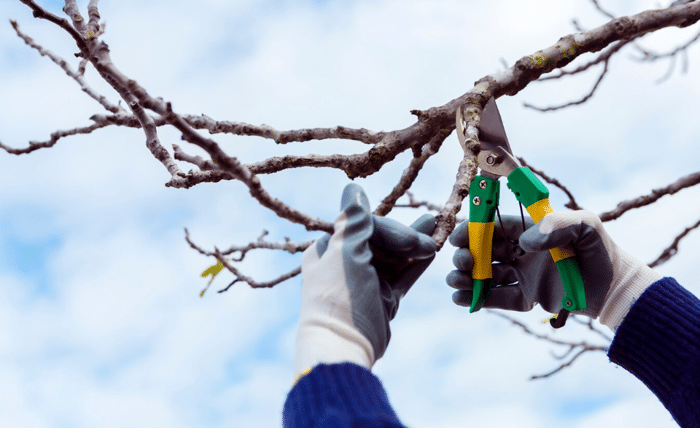
Winter presents unique challenges and opportunities for maintaining healthy fruit trees in British gardens. Proper care during the colder months ensures trees remain robust, productive, and prepared for the growing season. This article outlines essential practices for winter fruit tree care, tailored to the UK’s climate and gardening preferences. From pruning to pest management, these steps will help gardeners protect their trees and optimise future yields.
A nursery specialist from Chris Bowers, a respected UK supplier, offers this advice: “Winter is the ideal time to assess and maintain fruit trees, as dormancy allows for structural pruning and protection against harsh weather. Focus on removing dead or damaged wood and ensuring trees are safeguarded from frost and pests. For those looking to expand their orchard, selecting quality stock during this season is wise, as bare-root fruit trees are often available and easier to establish.”
Winter Dormancy in Fruit Trees
Fruit trees enter dormancy during winter, a natural state where growth slows to conserve energy. This period, typically from November to March in the UK, is critical for maintenance tasks that would stress trees during active growth. Dormancy reduces the risk of shock from pruning or transplanting, making winter the optimal time for structural care. Gardeners should monitor local weather patterns, as mild winters or late frosts can affect tree health. For instance, the UK’s temperate climate often brings unpredictable temperature fluctuations, requiring vigilance to prevent damage from sudden cold snaps.
During dormancy, trees rely on stored nutrients to survive. Ensuring trees enter winter in good health is vital, as weakened trees are more susceptible to disease and frost damage. Autumn preparations, such as mulching and fertilising, set the stage for successful winter care. Gardeners purchasing fruit trees for sale during this season should prioritise bare-root varieties, which are cost-effective and easier to plant while dormant. These trees establish strong root systems before spring growth begins.
Pruning for Health and Productivity
Pruning is a cornerstone of winter fruit tree care, shaping trees for optimal structure and fruit production. The absence of leaves during dormancy provides clear visibility of the tree’s framework, allowing precise cuts. Pruning removes dead, diseased, or crossing branches, which can harbour pests or obstruct airflow. For apple and pear trees, common in British gardens, winter pruning encourages vigorous spring growth and larger fruit yields.
Begin by inspecting the tree for damaged or weak branches. Use clean, sharp secateurs or loppers to make clean cuts just above a bud or branch collar, avoiding stubs that invite infection. For mature trees, aim to maintain an open canopy, allowing light and air to reach inner branches. Younger trees require formative pruning to establish a strong framework, typically a central leader or open goblet shape. Stone fruit trees, such as plums and cherries, are more prone to silver leaf disease, so pruning should be minimal and completed by early winter to reduce infection risk.
Gardeners should avoid over-pruning, as excessive cuts can stress trees and reduce fruiting potential. A general rule is to remove no more than 20-25% of the canopy in a single season. After pruning, clear debris from the base of the tree to prevent fungal growth. For those seeking new trees, winter is an excellent time to explore fruit trees for sale, as nurseries often offer discounts on bare-root stock suitable for immediate planting.
Protecting Trees from Frost and Cold
Frost and freezing temperatures pose significant risks to fruit trees, particularly young or newly planted ones. In the UK, where winters can bring sub-zero temperatures, protecting trees is essential. Young trees are especially vulnerable, as their root systems are less established. Wrapping trunks with horticultural fleece or burlap can shield them from frost cracks, where rapid temperature changes cause bark to split. For potted trees, consider moving them to a sheltered location, such as a garage, during extreme cold.
Mulching is another effective strategy. Apply a 5-10 cm layer of organic mulch, such as bark or compost, around the base of the tree, keeping it clear of the trunk to prevent rot. This insulates roots and retains soil moisture. In areas prone to heavy snow, gently shake branches to prevent snow accumulation, which can cause them to snap. For espaliered or trained trees, ensure supports are secure to withstand winter winds.
Gardeners in frost-prone regions should select hardy varieties when buying fruit trees for sale. Cultivars like ‘Cox’s Orange Pippin’ or ‘Conference’ pear are well-suited to the UK climate. Checking local frost dates and monitoring weather forecasts helps time protective measures effectively.
Pest and Disease Management in Winter
Winter is a prime time to address pests and diseases that can compromise fruit tree health. While many pests are dormant, their eggs or larvae may overwinter on branches or in soil. Inspect trees for signs of scale insects, aphid eggs, or fungal spores, and remove affected areas during pruning. Applying a dormant oil spray, a horticultural product, can smother overwintering pests and reduce spring infestations. Follow product instructions carefully, applying on a dry, non-freezing day.
Fungal diseases, such as apple scab or canker, can persist in fallen leaves or dead wood. Rake and dispose of debris to minimise infection risk. For trees with a history of disease, consider a winter fungicide spray, ensuring it’s approved for edible crops. Maintaining good hygiene around trees, including removing weeds and grass, reduces habitats for pests.
Gardeners expanding their collection should source fruit trees for sale from reputable nurseries, ensuring stock is certified disease-free. Regular winter inspections help catch issues early, preserving tree vitality.
Soil and Nutrient Care
Winter care extends to the soil, which supports tree health year-round. Test soil pH and nutrient levels in late autumn to identify deficiencies. Most fruit trees thrive in slightly acidic soil (pH 6.0-6.5). If adjustments are needed, incorporate lime to raise pH or sulphur to lower it, following test recommendations.
Apply a balanced fertiliser or well-rotted manure in late winter to replenish nutrients. Avoid high-nitrogen fertilisers, which stimulate growth vulnerable to frost. Instead, use a slow-release product with potassium and phosphorus to support root and fruit development. Spread fertiliser evenly around the drip line, where feeder roots are located, and water lightly if the soil is dry.
Compacted soil can hinder root growth, especially in clay-heavy regions. Lightly fork the soil around trees to improve aeration, taking care not to damage roots. Adding organic matter, like compost, enhances soil structure and drainage, critical for wet UK winters.
Preparing for Spring Growth
Winter care lays the foundation for a successful spring. As temperatures rise, trees exit dormancy, and early preparation ensures a smooth transition. Check stakes and ties on young trees, replacing any that are loose or damaged. Reapply mulch if it has decomposed, and inspect irrigation systems for leaks or blockages.
For gardeners planning to add to their orchard, late winter is a strategic time to order fruit trees for sale. Bare-root trees planted before bud break establish quickly, often bearing fruit within a couple of years. Review pollination requirements when selecting varieties, as many fruit trees need a compatible pollinator to set fruit. Nurseries like Chris Bowers provide detailed guides to simplify this process.
Monitor trees for early signs of bud swell, indicating the end of dormancy. If late frosts threaten, cover blossoms with fleece to protect developing fruit. Keeping a gardening journal to track winter tasks and tree performance helps refine care strategies over time.
Conclusion
Winter care for fruit trees is a proactive investment in long-term health and productivity. By pruning thoughtfully, protecting against frost, managing pests, and nurturing soil, gardeners can ensure their trees thrive in the UK’s challenging climate. Whether maintaining established trees or planting new ones, these practices foster resilient, fruitful orchards. With careful attention, the reward is a bountiful harvest and a garden that flourishes year after year.




